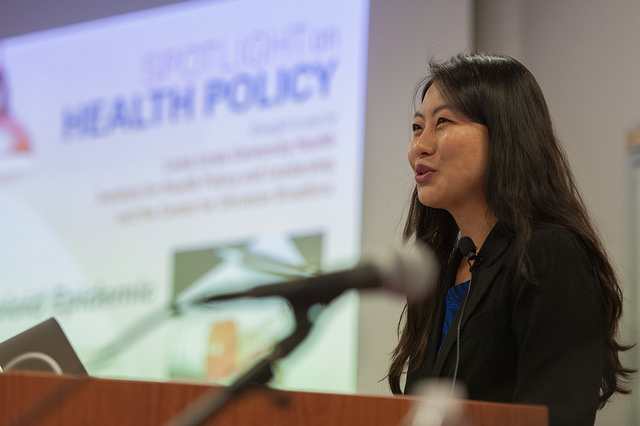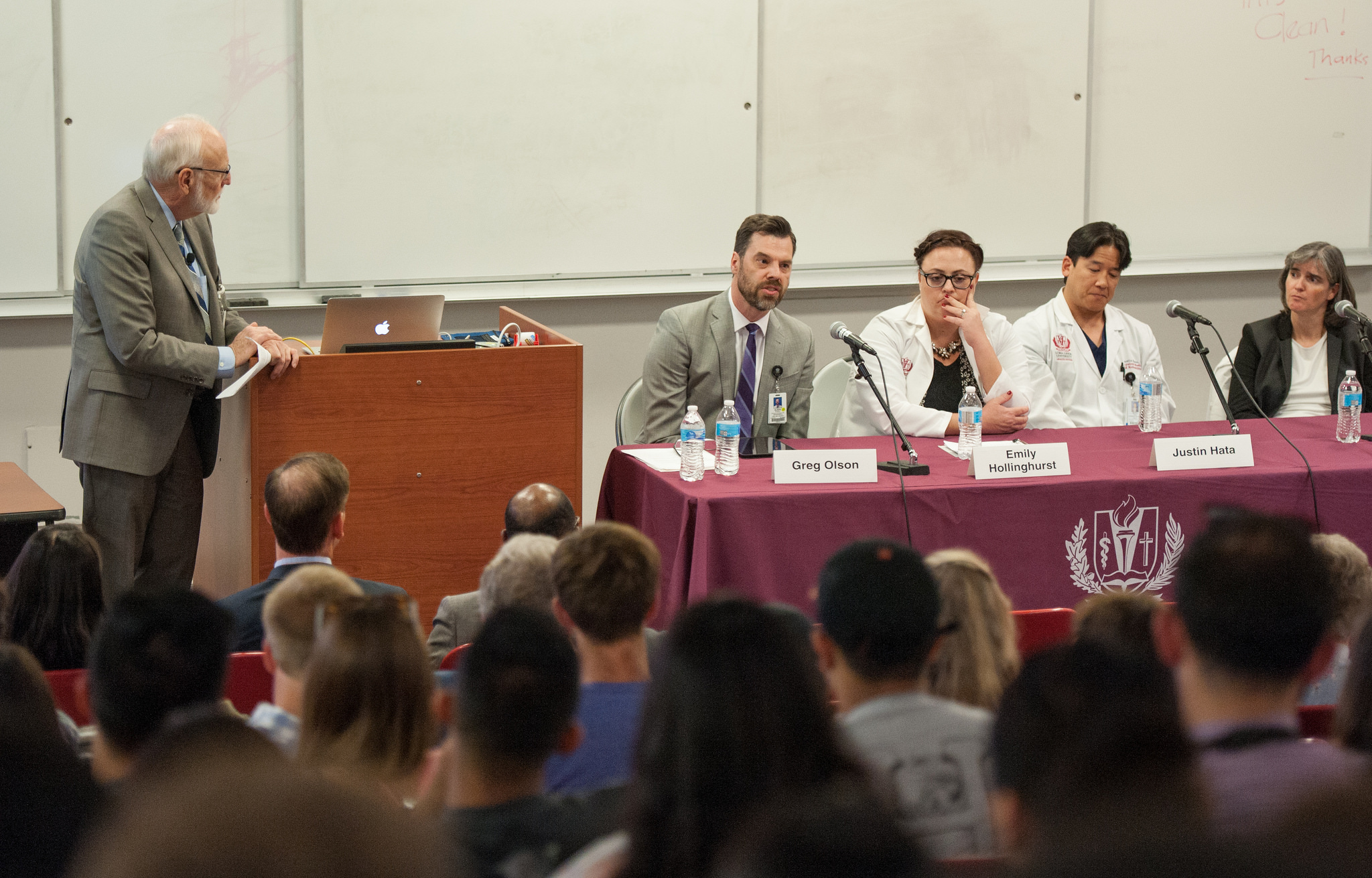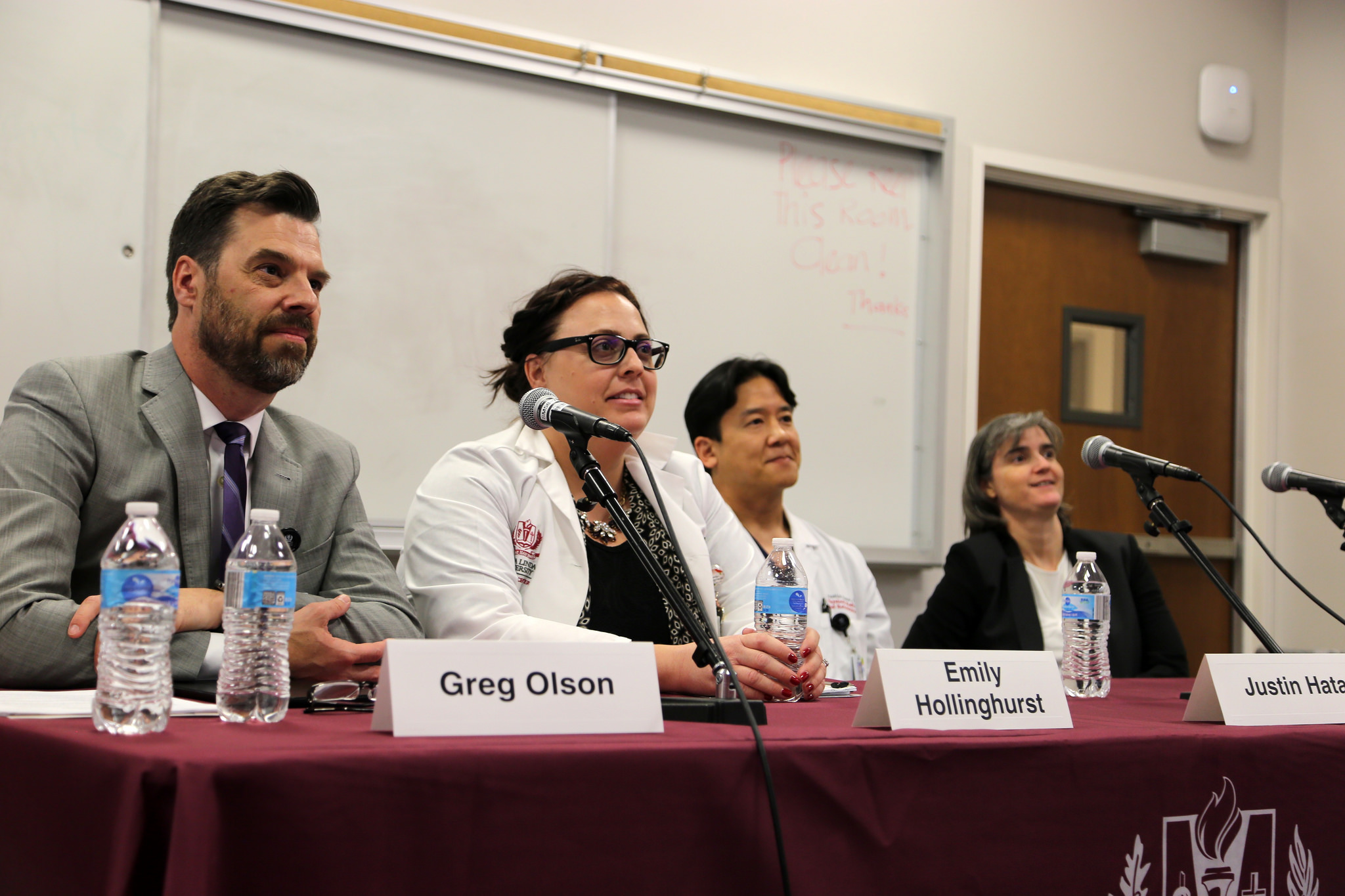
Wonha Kim, M.D., MPH, CPH, FAAP, director of the Institute for Health Policy and Leadership, welcomes guests to the opioid addiction presentation. Photo by Ansel Oliver
One of the nation’s most prominent health topics came into focus last month with a panel of Loma Linda University Health experts identifying issues surrounding the opioid addiction and abuse epidemic, setting the stage for discussion of proper pain management by health professionals and addressing underlying matters in addiction.
Presenters and four panelists convened on October 25 at Loma Linda University Medical Center for last month’s Spotlight on Health Policy meeting, which was organized by the Institute for Health Policy and Leadership and co-sponsored by the Center for Christian Bioethics.
At the start of the meeting, Wonha Kim, M.D., MPH, CPH, FAAP, director of the institute, told the estimate 175 attendees — comprising staff, faculty, students and administrators — that the problem with opioid pain relievers is that they induce feelings of euphoria in some users and often become addictive.
Kim said opioid addiction is associated with such negative consequences as job loss, homelessness, alienation from family and friends, transition to harder drugs such as heroin, and even death from overdose. She pointed out that opioid overdoses claim the lives of approximately 91 Americans per day.
“Let that sink in a little bit,” she said. “Ninety-one Americans each day.”
Kim reported that the total cost of the opioid epidemic — including expenditures for health care, lost productivity, addiction treatment and criminal justice — amounted to approximately $78.5 billion in 2015 alone.
She said fighting the epidemic will take a massive endeavor on the part of the government, individual health practitioners, and an informed public. After outlining several initiatives launched by the National Institutes of Health and other federal agencies, she turned her attention closer to home.
Initiatives on Campus
Kim said there are currently four Loma Linda University Health resources focused on the opioid epidemic.
The substance use recovery and wellness program at the Loma Linda University Behavioral Medicine Center: The program offers a five-to-seven-day medically managed inpatient detoxification program, a four-to-six-week outpatient rehab program, and aftercare groups for patients who have completed rehab.
The program is headed by psychiatrist Katia Stoletniy, M.D. In a separate interview, Stoletniy said patients with chronic pain have a special track within the detox and rehabilitation program. The rehab program involves group classes to learn about the disease of addiction, new coping skills and relapse prevention. Other features of the program involve spiritual care, family care, recreational therapy, mindfulness, yoga and exercise, among other things. Stoletniy added that participants in the chronic pain track program also have specialized groups focusing on pain education and process, acupuncture and massage.

Moderator Gerald R. Winslow, Ph.D. (left), director of the Center for Christian Bioethics, listens as Greg Olson, D.D.S., associate professor at the LLU School of Dentistry, answers a question related to the opioid epidemic. Photo by Ansel Oliver
The Opioid Project at the Institute for Health Policy and Leadership has two major objectives: the first is a review of medical and dental prescription data to identify areas for systematic improvement that can help prevent the potential for opioid addiction or abuse among patients. The second is to survey Loma Linda University Health practitioners about opioids and pain management perspectives and practices.
Research: Loma Linda University Medical Center was one of 10 health care organizations recently awarded a one-year, $39,000 grant from the Cardinal Health Foundation. The goal of the grants is to better engage health care providers, patients and caregivers in order to reduce the number of opioids prescribed for chronic, non-cancer pain.
The grant will be administered by Patti Radovich, Ph.D., CNS, FCCM, director of nursing research at the medical center, Huy Le, Pharm.D., assistant professor of pharmacy practice at the Loma Linda University School of Pharmacy, and Justin Hata, M.D., associate professor at the LLU School of Medicine and chair of the department of physical medicine and rehabilitation. The Medical Center plans to use the funds as a pilot study to create the No Pain program to improve chronic pain management through patient education and active patient engagement.
The LLU Health Care Opioid Steering Committee consists of physician leaders from the fields of primary care, pain management, and palliative care from Loma Linda University Health, as well as Riverside University Health System. The committee is developing best practices guidelines and a pain/controlled substance agreement, as well as working with the information services department to develop computerized tools to support best practices.
Panelists Report
Kim introduced four Loma Linda University Health providers — a dentist, a pharmacist and two physicians — to present their unique perspectives on the often-conflicting demands health care professionals must balance in order to provide the best care for their patients.
Panel moderator Gerald R. Winslow, Ph.D., director of the Center for Christian Bioethics at the LLU School of Religion, set a somber tone by announcing that the opioid epidemic has affected him personally.
“I lost an older sibling to an opioid addiction, so it’s not a matter of an abstract subject to me,” Winslow said. “I have also watched two friends go through this, and even though they’re still in the community, they’re not available for relationships much anymore. So, it’s a personal matter to me.”
Winslow turned his first question to the audience. “How many of you know people personally, family and friends or somebody in your circle of acquaintances, who have struggled with opioid addiction?”
As hands went up throughout the auditorium, Winslow added, “Just take a look around. This is why we’re talking about this today. That’s the majority of you,” he said.
In response to a question from Winslow about the geographic extent of the opioid crisis, panelist Justin Hata, M.D., chair of the department of physical medicine and rehab at Loma Linda University Health, said that while the epidemic is a problem everywhere in the United States, it has hit San Bernardino especially hard. He said he had noticed that opioid prescription requests from providers and patients have increased significantly in recent years.
Hata also pointed out that from a political and regulatory perspective, the pendulum has swung away from the over-prescribing of opioid medications to the situation today where few health care workers want to write such prescriptions. “I think that puts a lot of people at risk, and it’s going to be very challenging how we move forward,” he said.
Hata cited the logistical and economic pressure doctors face as reasons why they sometimes aren’t able to educate patients about the risks and benefits of their medications. He said when clinicians are encouraged to get patients out of the emergency department or surgical unit in a hurry so they can get the next patient in the door, it’s easy to neglect to take the time to properly educate the patient about their medication and potential side effects. “It’s easier just to write a prescription for 30 pills and say, ‘This is what you get.’ Time is a very precious commodity,” Hata said.
Greg Olson, D.D.S., associate professor at the LLU School of Dentistry, said a key way to take on the opioid epidemic is to have an organized method for making students aware of the complexities of the epidemic.
Olson said he attended a policy session three years ago for the American Dental Education Association in which he and his colleagues came up with ideas for the most appropriate ideas to employ against the opioid crisis. “Since then, I’ve been on a path to try and figure out what role dentistry plays in this,” he said.
Olson added that the central points that emerged from the meeting were that dentists have an obligation to monitor themselves and their colleagues for symptoms of addiction, and that they must also be alert for patients who keep calling back for refills of specific pain medications, particularly if they are in high-risk groups.
Citing a tagline posted on the National Public Radio website, which says ‘My dentist hooked me on opioids,’ Olson added, “We do that a lot through the extraction of third molars. That’s the classic one. We take out third molars and we give a prescription for hydrocodone or OxyContin and we let them go. And those people happen to be teenagers from 16 to 20 to 25, high risk.”
In echoing Hata’s comments about the time and logistical demands clinicians often face, Olson said that all the national attention focused on the opioid epidemic has placed us in a reactionary phase. He said it can make a world of difference if a dentist has time to talk to a patient about the level of discomfort they may experience and offer pain management strategies to help them cope. Unfortunately, he said good patient education takes time, energy, thought and supportive policies, but clinicians don’t always have those commodities. “There’s your conundrum,” he said.

Panelists listen to a question for the audience. Photo by Ansel Oliver
Pain Management
Winslow asked panelist Gina Mohr, M.D., director of palliative medicine at Loma Linda University Health, to describe her experience as an oncologist working with cancer patients, who often experience severe chronic pain.
After acknowledging the seriousness and scope of the misuse of opioids, Mohr cautioned that one-size-fits-all solutions will not work. “I think that there is a much broader issue when it comes to addiction. Most people don’t say, ‘I love my job, I love my family, I love my life, I’m going to start using drugs,’” Mohr said. “The larger issue is how do we combat the despair and hopelessness that people feel that then often contributes to drug abuse of all kinds?”
Mohr revealed that patient opinion about addiction is sometimes a problem when treating patients at Loma Linda University Medical Center’s Cancer Center. She shared the example of an octogenarian female patient who was taking hydrocodone every four hours for pain, yet bristled when Mohr suggested morphine might provide longer-lasting relief. “She looked at me horrified and said, ‘Do you think I’m a drug addict? Morphine is for addicts, right? I can’t take that!’ So, there are these thoughts and opinions about medication that may or may not be factual and accurate.”
Mohr said her biggest concern is how to resolve the problem of addiction without telling medical students and residents not to prescribe opioids ever to any patients. “And yet, when I talk to students they say ‘Yeah, that’s basically what my attendings are telling me.’ And I worry about that,” Mohr said. The term ‘attendings’ refers to house-staff physicians who often serve as clinical mentors in a teaching hospital setting.
Mohr said some recent government rulings have made it harder for her to obtain medications she feels her cancer patients need. In referencing the CDC Guideline for Prescribing Opioids for Chronic Pain, Mohr noted a disclaimer paragraph, which states that the guideline does not apply to people receiving active cancer treatment or palliative care. She noted, however, that regulators often ignore that one paragraph, choosing to apply the restrictions across the board. “I’m having difficulty getting pain medications for my cancer patients, and that’s just one of those unintended consequences.”
After noting that pharmacists are often on the front line in the battle against opioid addiction, Winslow asked Emily Hollinghurst, Pharm.D., BCOP, assistant professor at the LLU School of Pharmacy, for her perspective on the opioid epidemic.
Hollinghurst’s answer was carefully nuanced. She said the question of whether to prescribe the controversial painkillers is not easy to answer. She added that the education point when dealing with patients who are expected to have acute pain — as opposed to the long-term, chronic pain cancer patients often experience — is to ask them, “What pain score is tolerable to you?” She said it is important to give them the expectation that they may have pain after certain procedures.
“As a pharmacist on the oncology side, it is definitely difficult because you have patients with tumors that are compressing on nerves, and other issues causing a lot of pain,” Hollinghurst said. “But then you also have acute issues that are going to be treated with chemotherapy.”
Hollinghurst said she teaches pharmacy students and residents to talk with patients about what pain levels to expect. She confirmed Mohr’s observation that students are often taught about opioids in a black-or-white, all-or-nothing fashion, but insisted that opioids are often necessary to help patients manage powerful pain.
Winslow directed questions to the panelists for approximately 40 minutes before inviting members of the audience to join the discussion.
The room became quiet as one audience member shared his personal experience as a recovering opioid addict. He said he had received excellent and effective therapy, both on an inpatient and outpatient basis, at the LLU Behavioral Medicine Center.
Moments later, the audience broke into spontaneous applause when he reported that he has enjoyed two years of sobriety in the aftermath of his treatment.
— This article originally appeared on Loma Linda University Health's website on Nov. 13, 2017; click here for original.
